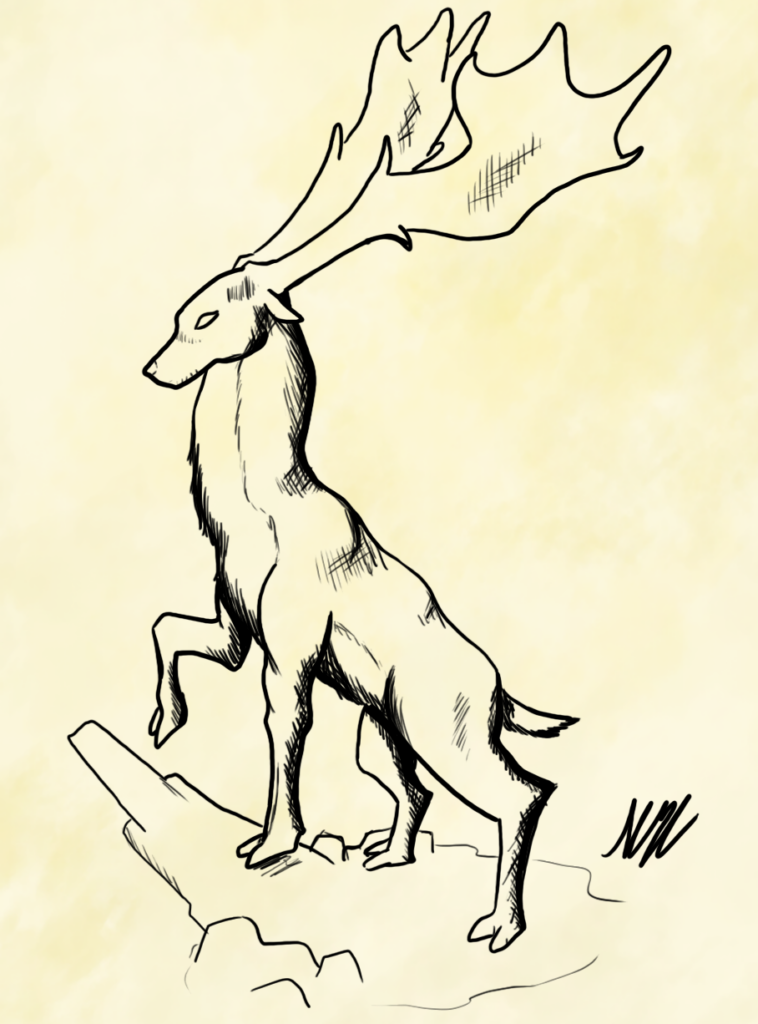Eikthyrnir
Eikþyrnir is a mythological stag in Norse mythology that resides atop Valhalla, the hall of the slain, where warriors go after death. The stag is often mentioned in connection with the great hall where Odin, the chief of the gods, hosts fallen warriors. Eikþyrnir is an important part of the natural world in Norse cosmology, representing the connection between the divine and the natural elements.


Characteristics of Eikþyrnir
- Location:
- Eikþyrnir stands on the roof of Valhalla, where it is part of the divine landscape. It is often associated with Yggdrasil, the World Tree, which connects the nine realms of Norse mythology. Eikþyrnir is sometimes seen as a symbol of the life force flowing through Yggdrasil.
- Water Flow:
- One of the most notable characteristics of Eikþyrnir is that water flows from its antlers. According to the Prose Edda, the great stag’s antlers drip water into the spring Hvergelmir, which is the source of many rivers that flow throughout the world, including some that reach the roots of Yggdrasil.
- The flowing water represents life and sustenance, connecting Eikþyrnir to the natural cycles of life, death, and rebirth.
- Antlers:
- Eikþyrnir’s massive antlers are a defining feature, symbolizing both strength and life-giving power. As water flows from them into the rivers, the antlers serve as a conduit for nourishing the world and sustaining the natural environment.
Symbolism of Eikþyrnir
- Cycle of Life:
- Eikþyrnir’s antlers and the water flowing from them are often interpreted as symbols of the cycle of life and nature. The water that flows from the stag gives life to the rivers and sustains the earth, just as life continues to flow through the natural world.
- Connection to Yggdrasil:
- Eikþyrnir is often associated with Yggdrasil, the cosmic tree that connects all realms in Norse mythology. The rivers flowing from Eikþyrnir’s antlers nourish the roots of Yggdrasil, further strengthening the stag’s connection to the life force that sustains all things.
- Divine Animal:
- As a stag that resides in Valhalla, Eikþyrnir is also seen as a divine animal, representing the connection between the gods and the natural world. It stands as a symbol of the majestic and powerful forces of nature that the gods themselves rely on.
Eikþyrnir in Norse Literature
- Snorri Sturluson’s Prose Edda provides much of the information about Eikþyrnir. In the Gylfaginning section, Eikþyrnir is mentioned as part of the mythological landscape surrounding Valhalla. The rivers that flow from its antlers are considered sources of life and nourishment for the world.
Conclusion
Eikþyrnir is an important figure in Norse mythology, symbolizing the flow of life and the interconnection of the natural world. As a stag whose antlers nourish the world through rivers, it embodies the idea of life’s ongoing cycles. Its presence in Valhalla, alongside the gods and fallen warriors, reflects the Norse belief in the sacred power of nature and its essential role in the balance of the cosmos.
Description

Eikþyrnir (ᛖᛁᚲᚦᛃᚱᚾᛁᚱ) meaning “oak-thorny” [1] is a stag living on Valhalla and eating on the tree Lærad’s branches. His horns exude a liquid that flows into the spring Hvergelmir and flows into the major rivers Sid, Vid, Sökin, Eikin, Svöl, Gunnthra, Fjöm, Fimbulthul, Gipul, Göpul, Gömul, and Geirvimul [2].
Author

Josh Morley holds a Bachelor’s degree in Theology from the Trinity School of Theology and a Diploma in Theology from the Bible College of Wales. His academic journey involved interfaith community projects and supporting international students, experiences that shaped his leadership and reflective skills. Now based in Liverpool, Josh is also the founder of Marketing the Change, a digital agency specializing in web design and marketing.
View all posts




